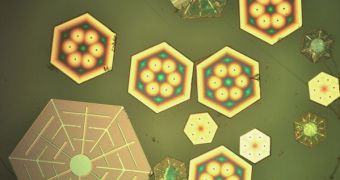Scientists at the US Department of Energy's (DOE) Sandia National Laboratories (SNL) have recently finished developing a new type of tiny solar cells. The new devices are no larger than the pieces of glitter that can be seen adorning holiday cards and hats, and can therefore even be woven into clothes, their creators say. In addition to this unique trait, the new photovoltaic cells could also conceivably be placed on rough, bent, or curved surfaces, which would considerably increase the number of homes that could support them, LiveScience reports.
Another very important trait that they have is the fact that they can be encapsulated in plastic. This means that they can be made flexible, and therefore suited to fit any form. “With this technology, one can envision ubiquitous [solar-powered] devices,” SNL scientist Greg Nielson, who has been the lead investigator of the new project, explains. The microcells that have already been developed at the labs are currently being kept inside vials containing isopropyl alcohol. The entire ensemble resembles a toy globe, which glitters when stirred, on account of the small molecules that make up its contents.
The components of the cells themselves form a honeycomb-like structure, so as to maximize the surface available for sunlight. The SNL team says that the new devices exhibited in lab tests a photovoltaic efficiency of around 15 percent, which is more than some of the most advanced, commercially available solar panels out there today can boast. This percentage refers to the portion of the light that is shone on the solar cells that is converted into actual, collectible electrical energy. Nielson believes that the microcells could soon grow to be even more efficient than the current top-notch solar panels, which can convert about 20 percent of the sunlight they catch.
In spite of the complex manufacturing process, and of the advanced materials used in the cells, the SNL experts believe that the new cells could hit the market at an affordable price that would not alienate currently undecided customers. “It's great and important that we reduce cost potential by going this way, but what's more exciting is what you can do with these cells that you can't with anything else,” the expert adds. Because the new solar cells are flexible, a host of new applications may be opened up for them, where existing panels cannot be of use. “You don't have large-area wafers that are rigid and don't bend,” he concludes.

 14 DAY TRIAL //
14 DAY TRIAL //